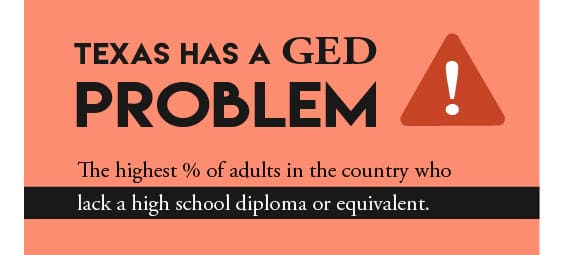Texas has the highest percentage of adults in the country that lack a high school diploma or equivalent. Changes to the national GED test in 2014 exacerbated this problem by making the test more expensive, computer-based only, and harder to complete.
Between 2003 and 2012, an average of 33,700 students per year from across the state received their high school equivalency credential by passing the GED. During the same time period, there was a gradual decline in the number of test takers in the state, despite significant population growth. After changes to the GED test, only 21,000 Texans earned a high school equivalency in 2016.
Though the State Board of Education (SBOE) recently approved new exam options in Texas, overall the state’s education system does not do enough to help the more than 3 million adults that did not complete high school obtain their high school credentials.

Last year, the state announced a strategic plan for higher education, with a goal of ensuring that 60 percent of the state’s 25-34 year olds receive a college credential or workforce certification by 2030. That’s great, but there’s a glaring issue in this plan: it doesn’t include a strategic plan for addressing the large number of adults who currently lack the high school credential needed to purse higher education. We cannot accomplish the state’s goal, or continue to drive our economy forward, without considering the three million adults without a high school diploma or equivalency.
The good news is that the SBOE is conducting listening sessions to help formulate a long-range plan for K-12 education. The long-range plan should include specific steps for improving statewide participation and performance on high school equivalency tests.
To learn more about Texas’ GED problem and our recommendations on how to fix it, read our new report, The Texas GED Problem is Getting Worse. The report is a follow-up to CPPP’s July 2015 report, Texas Has a GED Problem.
